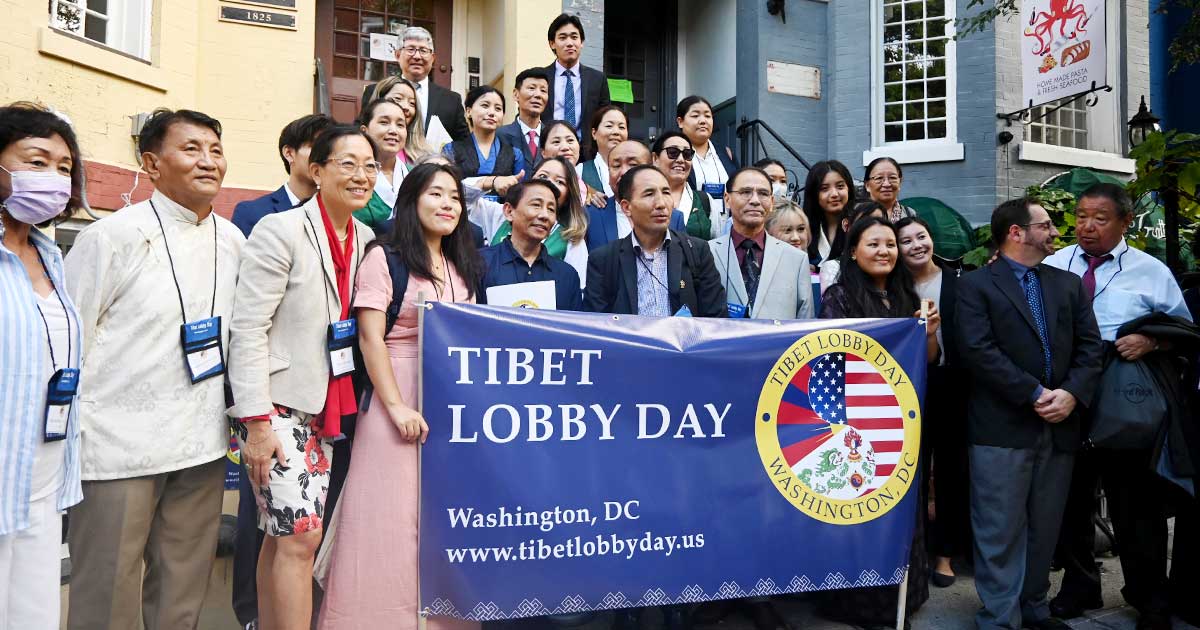By Tinley Nyandak. Tinley Nyandak is a Tibetan American who served in the Office of Tibet in New York and subsequently at the Voice of America in Washington, D.C.
The International Campaign for Tibet (ICT) scheduled September 22 and 23, 2022 as Tibet Lobby Day on Capitol Hill, requesting US Congressional members to support a new piece of legislation on Tibet: the “Promoting a Resolution to the Tibet-China Conflict Act.”I signed up for Lobby Day, and on September 22nd I got up early to take the bus to Washington, DC. This was the first time I’ve visited DC since the Covid-19 pandemic forced the closure of my office; I had been working from home until I retired two years ago.
When I got to the ICT there were a lot of people gathering for Lobby Day, in particular young Tibetans. We were put into groups of four or five, and in my group there were two young Tibetan ladies and one elderly American lady who came all the way from Montana, a trip which took her four days by train.

Tinley Nyandak (on extreme right in white shirt) and other participants of this year’s Tibet Lobby Day
We took a taxi and headed to the Hill to meet staff members of our members of Congress. The meetings were scheduled earlier by ICT,and I was so happy that the staff members on Capitol Hill really paid close attention to what we had to say, took notes, and asked questions. They promised that they would report our requests to their bosses, i.e., Representatives and Senators.
I was also very impressed by presentations made by my two fellow Tibetans: Lobsang Kyizom La from New York and Tenzin Dadon La from Utah. They were very well informed of the current situation in Tibet and their presentation skill was just convincing and fantastic. Of course, Liz McClain from Montana is a veteran lobbyist; she told us that she has been doing Tibet lobbying with ICT for the past four years. My heart-felt gratitude and thanks to Liz McClain for her tireless efforts on behalf of suffering Tibetans in Tibet.
This reminded me of another intense campaign we did on the Capitol Hill 44 years ago (Oh Gosh! I am old, even though I feel young at heart). At the time, there were only a few hundred Tibetans in the United States, and only a handful of them were US citizens.
At the time, I was working at the Office of Tibet in New York. One day Ngawang Phakchok, one of the Tibetans who came to US to do a lumber jack work up in the Maine in early 1960s, came to see me. He told me about his problem. He said that in August 1977, he applied for a US passport so that he can go to India to see his relatives whom he has not seen for many years. When he got the passport, the State Department put his birthplace as “China,” not Tibet.
So, he contacted the State Department, requesting for correction. William B. Wharton, chief of the legal division of the passport office, said in a letter, “Tibet is located in present day China, therefore, China will have to be listed as your place of birth.”
Phakchok was now faced with a dilemma: accept or refuse the passport. He chose the latter and had to postpone his India trip. Based on our conversation, I wrote an Op-Ed piece and sent it to the New York Times. To my pleasant surprise, on February 18, 1978, the New York Times published my piece under the title of “When a Tibetan’s Not Tibetan.”
The New York Times, The Wall Street Journal and several other newspapers wrote editorials supporting the Tibetan case. Please bear in mind the power of the media; we Tibetans or Tibetan organizations must have constant contact with both print and electronic media so that when we have an event that needs coverage, we will have our friends right there. It is not easy to get coverage of our events by major media, but constant work will pay off eventually.
In 1978, we also came to the Capitol Hill seeking congressional support for our case. Eventually, the State Department agreed that Tibetan Americans can list their birthplace, city or the town they were born. So, if you were born in Lhasa, your birthplace will be Lhasa. In my US passport, my birthplace is Phenpo.
Similarly, Tibetans in Canada had asked the Canadian government that Tibet and not China be shown as their birthplace on Canadian passports.
In an era when we are too often reduced to categories anyway, the least our government can do is to give us the categories we choose.

